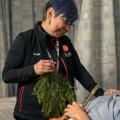Coronary artery bypass grafting
An overview of coronary artery bypass grafting including what to expect and how to prepare.
Overview
Coronary artery bypass grafting (CABG or “cabbage”) is a surgery used to re-route blood around blockages in your heart’s arteries. In this surgery, blood vessels from the legs, arms or chest may be used to “bypass” the blockages.
The purpose of coronary artery bypass surgery is to improve the blood flow to the heart. As a result, angina (chest pain or discomfort that occurs when part of your heart muscle does not get enough oxygen-rich blood) and shortness of breath should be improved and the heart will work better.
Our CABG surgical team and follow-up are team is made up of many expert professionals including:
- Surgeons
- Nurse Practitioners
- Cardiologists
- Residents/Fellows (medical students)
- Nurses
- Physiotherapists
- Occupational Therapists
- Social Workers
Common tests & imaging
You may be asked to do one or more tests to prepare for this surgery. You can learn more about them here.
Preparing for surgery
We will see you in our Pre-assessment Clinic before your surgery. This is where x-rays and other tests will be arranged. We will also tell you when to stop eating and drinking, what medications to discontinue and other information to help you prepare for your surgery.
Planning ahead for your surgery and recovery after surgery can decrease the anxiety you and your family may experience throughout this process.
During the surgery
Most commonly, the surgery will take anywhere from 3-6 hours. You will be asleep under general anesthetic (which renders you completely unconscious and insensitive to pain). The care team will take the following steps:
- The surgeon will make an incision in your chest and open your breastbone to expose the heart.
- You will then be placed on the heart-lung machine, which takes over the job of circulating the blood to the body and brain from the heart during the surgery. This allows the heart to be stopped to do the surgery.
- A blood vessel (graft), will be taken from your chest, arm or leg to create the bypass around the blockage. The grafts used most often include the arteries along the inside of the chest wall (mammary artery), a large vein in the leg (saphenous vein) or an artery in your arm (radial artery).
- Your surgeon will sew one end of the graft to the heart below the blockage and the other end to the aorta.
- When this is done, oxygen-rich blood can flow from the aorta through the graft to feed your heart muscle. The blockage is bypassed entirely.
There are now some new variations to the traditional approach to open heart surgery. In some conditions, the heart may be operated on while still beating—avoiding the use of the heart-lung machine. This is called beating-heart or off-pump surgery. There are other minimally invasive surgeries that can be done by entering the chest through a small incision between the ribs. Your surgeon will discuss whether these may be appropriate options for you.
After the surgery
After your surgery you will stay in the cardiac surgery intensive care unit (CSICU) for a day or two, or longer if needed. Once you are ready for the ward you will be transferred to 5B which is located on the 5th floor of the Providence building.
Typically, your discharge from hospital will occur 4 to 7 days after your surgery. You may have to stay longer depending on your recovery. You should start planning for both your discharge from hospital and your recovery at home at this time if you did not do any planning before you came to hospital.
Follow-up care
In most cases, general recovery from cardiac surgery takes approximately 6 to 12 weeks. During that time, follow-up care may include the following:
- making a follow-up appointment with your family doctor making a follow-up appointment with your heart specialist
- going for follow-up blood work in the community
- being referred to a cardiac rehabilitation program, where you will receive education and support to help you recover from your surgery
Information about your specific follow-up care will be given to you at the time of discharge.
Support for Indigenous Peoples
The Indigenous Wellness Liaison Team is here to support your health journey. Team members offer cultural support and healthcare advocacy. Learn more below or call them at 604-682-2344,62937 or email IWL@providencehealth.bc.ca.
Education & resources
Patient education
- Heart Surgery Patient Guide
- Your Heart Surgery at St. Paul's Hospital (English)
- Your Heart Surgery at St. Paul's Hospital (Russian)
- Your Heart Surgery at St. Paul's Hospital (Punjabi)
- Your Heart Surgery at St. Paul's Hospital (Polish)
- Your Heart Surgery at St. Paul's Hospital (Mandarin)
- Your Heart Surgery at St. Paul's Hospital (Farsi)
- Your Heart Surgery at St. Paul's Hospital (Cantonese)
- Discharge Teaching (video)
- Physio Cardiac Surgery Recovery Teaching (video)
Location
This procedure is done at St. Paul’s Hospital.
- If you have questions about your upcoming heart surgery, you should contact your heart surgeon’s office.
- If you don’t have a heart surgeon assigned to your case yet, then it is best to contact your cardiologist or family practitioner.

